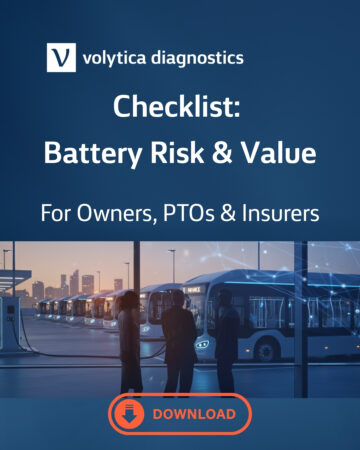
Battery Risk Assessment in E-Bus Financing & Insurance
Why Independent Monitoring Is Becoming Standard
Battery risk assessment is becoming a key concern for e-bus financing and insurance. As fleets grow, batteries emerge as the most valuable yet unpredictable component.
Underwriters, asset managers, and fleet financiers face the growing challenge of evaluating and insuring high-value assets with limited standardization, fluctuating residual values, and incomplete visibility.
Although Battery Management Systems (BMS) and OEM dashboards provide baseline data, they lack the independence, depth, and transparency required for due diligence. Risk modeling, warranty forecasting, and resale decisions require neutral, audit-able insights, especially since battery packs can cost up to €175,000 per vehicle and represent 30–35% of a bus’s total value (eBRT2030 study).
Even with solid engineering and conservative use cases, real-world data shows:
- 7% of electric buses show recurring battery issues
- 10–20% of batteries need replacement before warranty ends
- Warranty contracts typically last 5–8 years, while fleets are financed for 10+
A thorough battery risk assessment builds the trust needed to secure financing, reduce premiums, and extend asset life.
Battery Risk Assessment: What Financial Stakeholders Must Know
Factor | Typical Value / Practice (Europe) | Source |
| Warranty period | 5–8 years for battery/drive unit | eBRT2030 TCO study |
| Probability of replacement | ~10–20% before end of warranty | Zenobe, Fleeteurope, Connected Energy |
| Battery cost * for 12-meter depot-charging e-bus) | €140,000–175,000 (30–35% of vehicle cost) | BloombergNEF, eBRT2030 TCO study |
| Key insurer concerns | Fire risk, replacement cost, recycling liability, data transparency, early failure risk (~7% of e-buses) | WTW, DWF Group, volytica diagnostics |
| EU regulatory requirements | CE-marking, battery passport, recycling liability, carbon footprint | VDE, EU Regulation 2023/1542 |
| Independent condition assessment | Enables resale, supports warranty, informs underwriting | UITP, Fleeteurope, volytica
|
Why Independence Matters
OEM monitoring tools are designed primarily for warranty compliance, not external risk assessment. Their varying thresholds and KPIs leave operators, insurers, and financiers without a common baseline.
Independent battery analytics closes this gap by establishing a neutral, cross-brand source of truth, which enables objective underwriting, consistent asset valuation, and reliable resale documentation.
Use case: Enabling reselling of 5% of the EU fleet at once
In 2022, the largest used electric bus transaction in European history happened: 259 fully electric buses from BYD changed operators.
 Crucial to this multi-million euro deal was a rigorous, independent battery assessment provided by TÜV NORD Mobility and volytica diagnostics.
Crucial to this multi-million euro deal was a rigorous, independent battery assessment provided by TÜV NORD Mobility and volytica diagnostics.
This evaluation was needed to overcome buyer concerns and establishing transparency.
volytica’s analytics platform delivered an objective, data-driven report for each vehicle by evaluating parameters such as degradation behavior, charging history, safety-relevant anomalies, and projected remaining useful life.
These insights were based on raw BMS data and fleet benchmarks, not just OEM-reported metrics.
Battery Data: The Shift from Optional to Essential
Insurance and financing partners are increasingly requiring independent battery data. Residual value projections, safety profiles, and warranty coverage depend on verified third-party insights. In some cases, analytics already influence premiums and contract terms.
The takeaway for operators is clear: don’t wait until analytics become a requirement—implement them early to gain control, reduce risk, and strengthen future asset strategies.
Battery Risk Management: 8 Key Actions for PTOs and Investors

To prepare electric fleets for financing, you should:
- Confirm warranty scope. Duration, exclusions, and conditions vary.
- Review average failure rates. Industry benchmarks show 10–20% of batteries require early replacement.
- Request independent battery health data, not just OEM system outputs.
- Address resale and warranty needs. Plan diagnostics and documentation from day one.
- Compare failure and degradation patterns across vehicle types and suppliers.
- Assess the impact of analytics on financing. Premiums and terms are increasingly dependent on real battery insights.
- Plan for EU compliance by tracking recyclability, battery passports, and SoH KPIs.
- Use verified diagnostics for due diligence, which is essential in insurer and lender negotiations.
Want the full, printable checklist?
Download the Battery Risk & Value Checklist for Fleet Owners & Insurers (PDF).
Battery Risk Assessment Takeaway
There is one clear, actionable step for fleet operators: do not wait for insurers or financiers to demand analytics — get ahead of the curve.
Implementing independent battery analytics today builds the transparency and trust necessary for tomorrow’s financing, resale, and insurance requirements.
Curious to explore the full insights, case studies, and operator experiences?
Download Our Free White Paper: Why You Do Need Battery Analytics for E-Buses (available in English and Spanish)


